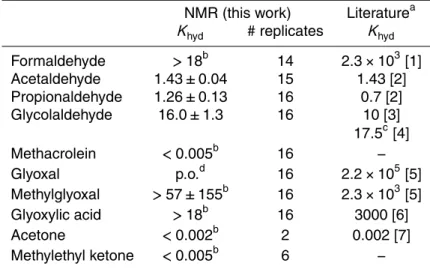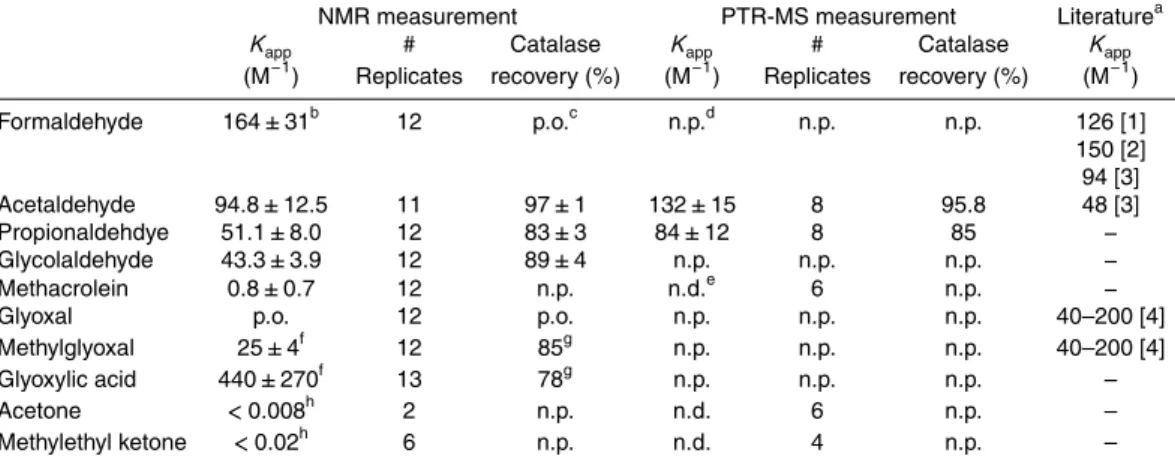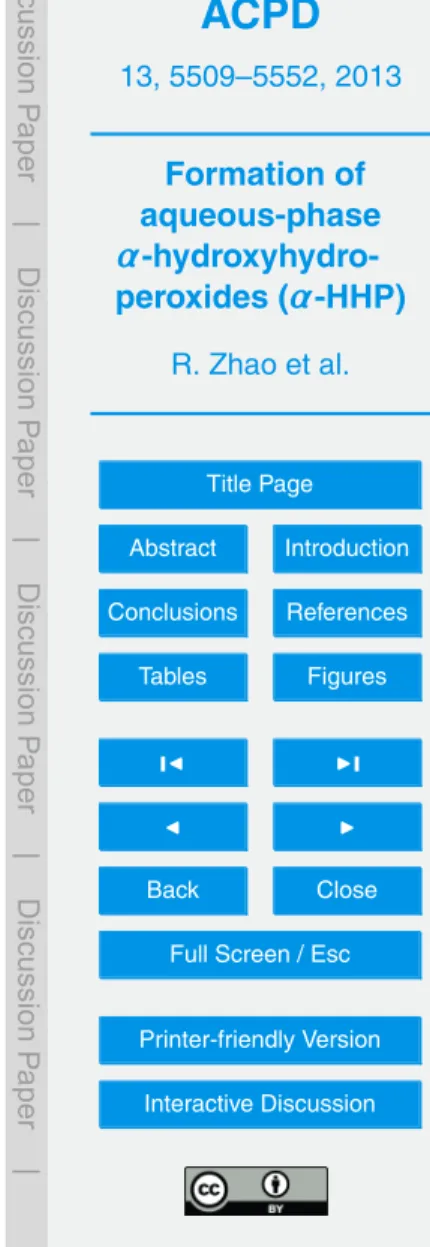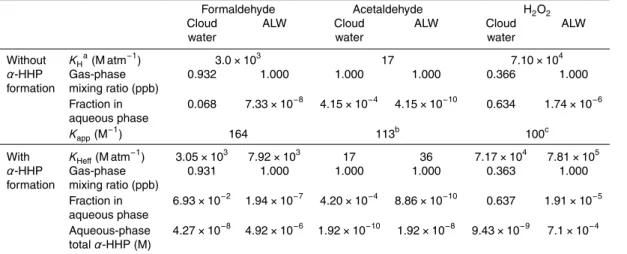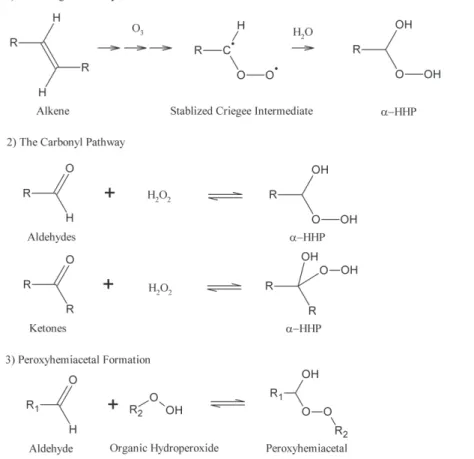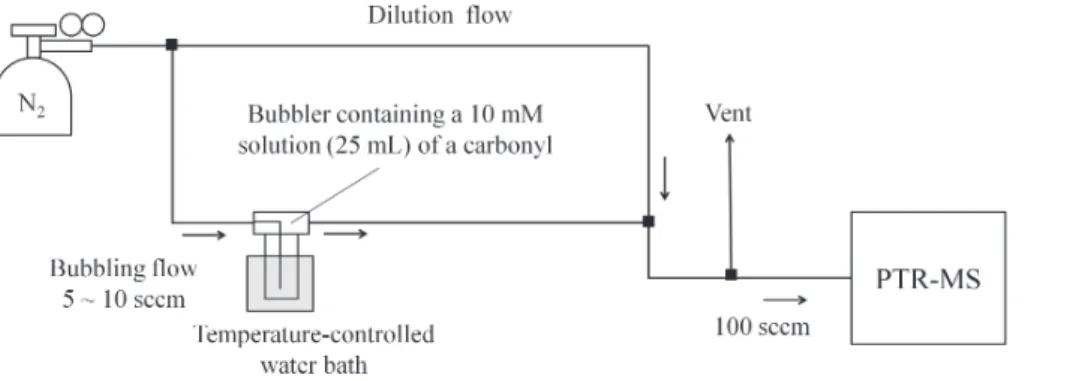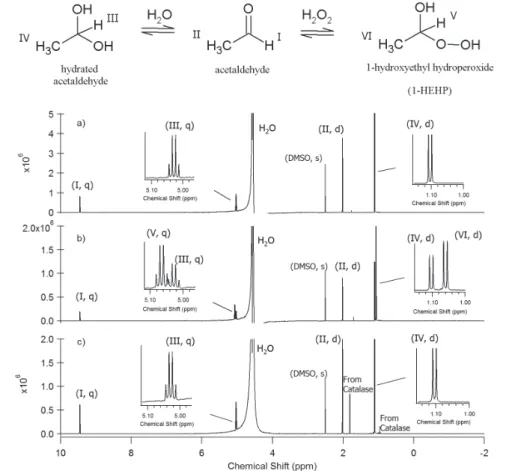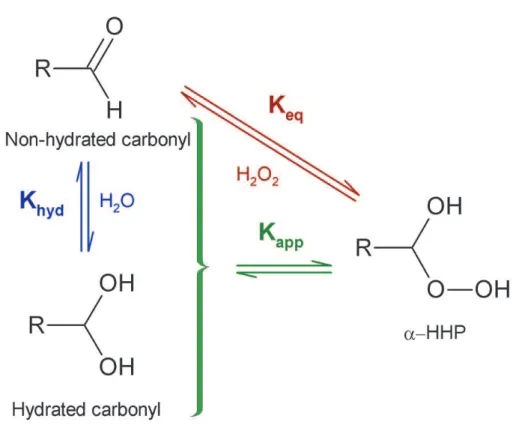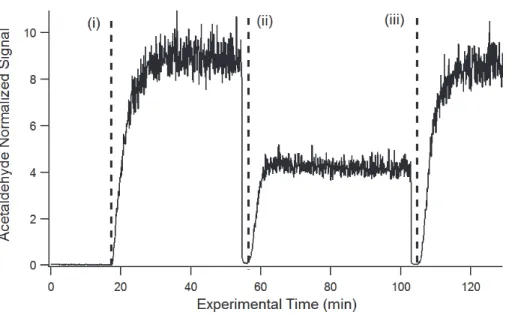ACPD
13, 5509–5552, 2013Formation of aqueous-phase
α
-hydroxyhydro-peroxides (α-HHP) R. Zhao et al.
Title Page
Abstract Introduction
Conclusions References
Tables Figures
◭ ◮
◭ ◮
Back Close
Full Screen / Esc
Printer-friendly Version
Interactive Discussion
Discussion
P
a
per
|
Dis
cussion
P
a
per
|
Discussion
P
a
per
|
Discussio
n
P
a
per
Atmos. Chem. Phys. Discuss., 13, 5509–5552, 2013 www.atmos-chem-phys-discuss.net/13/5509/2013/ doi:10.5194/acpd-13-5509-2013
© Author(s) 2013. CC Attribution 3.0 License.
Atmospheric Chemistry and Physics
Open Access
Discussions
Geoscientiic Geoscientiic
Geoscientiic Geoscientiic
This discussion paper is/has been under review for the journal Atmospheric Chemistry and Physics (ACP). Please refer to the corresponding final paper in ACP if available.
Formation of aqueous-phase
α
-hydroxyhydroperoxides (
α
-HHP):
potential atmospheric impacts
R. Zhao1, A. K. Y. Lee1, R. Soong2, A. J. Simpson2, and J. P. D. Abbatt1
1
Department of Chemistry, University of Toronto, Toronto, ON, Canada
2
Environmental NMR Centre, University of Toronto, Toronto, ON, Canada
Received: 12 February 2013 – Accepted: 13 February 2013 – Published: 27 February 2013
Correspondence to: J. P. D. Abbatt (jabbatt@chem.utoronto.ca)
ACPD
13, 5509–5552, 2013Formation of aqueous-phase
α
-hydroxyhydro-peroxides (α-HHP) R. Zhao et al.
Title Page
Abstract Introduction
Conclusions References
Tables Figures
◭ ◮
◭ ◮
Back Close
Full Screen / Esc
Printer-friendly Version
Interactive Discussion
Discussion
P
a
per
|
Dis
cussion
P
a
per
|
Discussion
P
a
per
|
Discussio
n
P
a
per
|
Abstract
The focus of this work is on quantifying the degree of the aqueous-phase formation ofα-hydroxyhydroperoxides (α-HHPs) via reversible nucleophilic addition of H2O2 to
aldehydes. Formation of this class of highly oxygenated organic hydroperoxides rep-resents a poorly characterized aqueous-phase processing pathway that may lead to 5
enhanced SOA formation and aerosol toxicity. Specifically, the equilibrium constants ofα-HHP formation have been determined using proton nuclear resonance (1H NMR) spectroscopy and proton transfer reaction mass spectrometry (PTR-MS). Significant
α-HHP formation was observed from formaldehyde, acetaldehyde, propionaldehyde, glycolaldehyde, glyoxylic acid, methylglyoxal, but not from methacrolein and ketones. 10
Low temperatures enhanced the formation ofα-HHPs but slowed their formation rates. High inorganic salt concentrations shifted the equilibria toward the hydrated form of the aldehydes and slightly suppressedα-HHP formation. Using the experimental equilib-rium constants, we predict the equilibequilib-rium concentration of α-HHPs to be in the µM level in cloud water but may be present in the mM level in aerosol liquid water (ALW), 15
where the concentrations of H2O2 and aldehydes can be high. Formation ofα-HHPs
in ALW may significantly affect the effective Henry’s law constants of H2O2and aldehy-des but may not affect their gas-phase levels. The photochemistry and reactivity of this class of atmospheric species have not been studied.
1 Introduction 20
Recent studies have shown that organic peroxides can be a significant portion of sec-ondary organic aerosol (SOA) (Bonn et al., 2004; Docherty et al., 2005; Kroll and Seinfeld, 2008). Besides their contribution to SOA, organic peroxides also damage plant leaves (Polle and Junkermann, 1994), contribute to acid precipitation by oxidizing SO2 to H2SO4 in the aqueous phase (Lind et al., 1987), and regenerate OH
radi-25
ACPD
13, 5509–5552, 2013Formation of aqueous-phase
α
-hydroxyhydro-peroxides (α-HHP) R. Zhao et al.
Title Page
Abstract Introduction
Conclusions References
Tables Figures
◭ ◮
◭ ◮
Back Close
Full Screen / Esc
Printer-friendly Version
Interactive Discussion
Discussion
P
a
per
|
Dis
cussion
P
a
per
|
Discussion
P
a
per
|
Discussio
n
P
a
per
2010).α-Hydroxyhydroperoxides (α-HHPs) constitute a class of organic peroxide that has been observed in ambient air (He et al., 2010), rain water (Hellpointner and Gab, 1989; Sauer et al., 1996), and cloud water (Sauer et al., 1996; Valverde-Canossa et al., 2005), as reviewed by Hewitt and Kok (1991) and Lee et al. (2000).
Despite their observation in the atmosphere, our understanding of the formation 5
mechanisms ofα-HHP is still incomplete. It has been suggested that the recombination reaction of peroxy radical (RO2) and hydroperoxy radical (HO2), which is the major
for-mation of organic hydroperoxides in gas phase, may not be a major forfor-mation pathway forα-HHPs (Carter et al., 1979; Atkinson 1990; Gab et al., 1995). Instead, other forma-tion pathways, including aqueous-phase reacforma-tions have been proposed (Fig. 1). The 10
first formation pathway, herein referred to as the Criegee Pathway, involves hydrolysis of the stabilized Criegee Intermediate (SCI) generated during alkene ozonolysis (Lee et al., 2000; Hasson et al., 2003; Ziemann and Atkinson, 2012). The second pathway involves reversible nucleophilic addition of H2O2 to carbonyls and is herein referred to as the Carbonyl Pathway (Hellpointner and Gab, 1989; Zhou and Lee, 1992). The 15
Criegee Pathway has gained the majority of attention becauseα-HHPs have been ob-served from chamber ozonolysis of a variety of alkenes and monoterpenes (Hewitt and Kok, 1991; Neeb et al., 1997; Sauer et al., 1999; Hasson et al., 2001; Hasson and Paulson, 2003; Wang et al., 2012). This reaction pathway occurs in both the gas and aqueous phases but a few studies (Gab et al., 1995; Chen et al., 2008; Wang et al., 20
2012) have shown that aqueous-phase ozonolysis may lead to more efficient formation ofα-HHPs compared to their gas-phase counterparts. In these studies, however, α -HHPs formed in the aqueous phase dominantly decomposed to H2O2 and aldehydes when analyzed under dilute conditions. The observed rapid decomposition ofα-HHPs in such laboratory experiments has lead to a general perception thatα-HHPs are un-25
stable, and are merely a class of intermediates in the formation of carbonyls and H2O2 during ozonolysis.
ACPD
13, 5509–5552, 2013Formation of aqueous-phase
α
-hydroxyhydro-peroxides (α-HHP) R. Zhao et al.
Title Page
Abstract Introduction
Conclusions References
Tables Figures
◭ ◮
◭ ◮
Back Close
Full Screen / Esc
Printer-friendly Version
Interactive Discussion
Discussion
P
a
per
|
Dis
cussion
P
a
per
|
Discussion
P
a
per
|
Discussio
n
P
a
per
|
and laboratory SOA extract (Liu et al., 2012) using advanced mass spectrometric tech-niques. Specifically, in our previous work (Zhao et al., 2012), α-HHP formation from glyoxal and methylglyoxal with H2O2was monitored using an iodide (I−) chemical
ion-ization mass spectrometer coupled to a heated inlet line (Aerosol CIMS). This tech-nique enabled the direct detection and characterization ofα-HHPs using online mass 5
spectrometry. In particular, the formation of α-HHPs from glyoxal and methylglyoxal was observed to be fast and reversible, with equilibrium constants between 40 and 200 M−1for both compounds. As described below, an equilibrium constant of this mag-nitude suggests thatα-HHPs could be formed in significant concentrations in aerosol liquid water (ALW) if aldehyde and H2O2concentrations are high (Arellanes et al., 2006; 10
Volkamer et al., 2009; Lim et al., 2010). However, the quantification using Aerosol CIMS is potentially complicated by thermodecomposition ofα-HHPs and unknown processes involving droplet evaporation in the heated inlet, giving rise to the need for a more quan-titative study using alternative techniques.
We note that although the Carbonyl Pathway is rarely discussed in the atmospheric 15
chemistry literature, it has been studied somewhat in the 1940’s and 50’s by physical organic chemists using high precursor concentrations. For example, the formation ofα -HHPs has been observed from several aldehydes (Satterfield and Case, 1954; Sander and Jencks, 1968) and ketones (Milas and Golubovic, 1959a,b). We also note that a closely related particle phase-reaction, peroxyhemiacetal formation (Fig. 1, pathway 20
3), which involves nucleophilic addition of an organic hydroperoxide to an aldehyde, has been previously proposed. (Tobias and Ziemann, 2000). Now, small carbonyls are gaining attention as potential SOA precursors via aqueous-phase processing (Ervens et al., 2011). The formation ofα-HHP via the Carbonyl Pathway may provide an addi-tional mechanism of processing of such carbonyls in the atmospheric aqueous phase. 25
As well, the formation ofα-HHP may also have significance to laboratory photooxida-tion experiments, where H2O2is commonly used as a precursor for OH radicals.
con-ACPD
13, 5509–5552, 2013Formation of aqueous-phase
α
-hydroxyhydro-peroxides (α-HHP) R. Zhao et al.
Title Page
Abstract Introduction
Conclusions References
Tables Figures
◭ ◮
◭ ◮
Back Close
Full Screen / Esc
Printer-friendly Version
Interactive Discussion
Discussion
P
a
per
|
Dis
cussion
P
a
per
|
Discussion
P
a
per
|
Discussio
n
P
a
per
stants ofα-HHP formation via the Carbonyl Pathway from a range of atmospherically relevant carbonyl compounds using two separate analytical methods: proton nuclear magnetic resonance (1H NMR) spectroscopy and proton transfer reaction mass spec-trometry (PTR-MS).1H NMR spectroscopy directly quantifies the chemical changes in the aqueous phase when a carbonyl is mixed with H2O2, and is particularly well suited
5
for the investigation of thermodynamic equilibria. On the other hand, online PTR-MS measurement of the gas-phase concentration of carbonyls after addition of H2O2 pro-vides better insight into the kinetics of the reactions and can assess the impact of
α-HHP formation on the effective Henry’s law constants (KHeff) of the carbonyls. We note that thermodynamic information of the type derived in this paper is required to 10
quantify the importance of different derivative organics in aerosol and cloud water, and yet it is frequently missing from the literature. The paper concludes with an assessment of the atmospheric importance ofα-HHP formation by the Carbonyl Pathway.
2 Experimental
2.1 1H NMR measurements 15
The formation of α-HHPs from a suite of atmospherically relevant carbonyl species has been studied: formaldehyde (Sigma Aldrich, 37 wt % in water with 10–15 % methanol as stabilizer), acetaldehyde (Sigma Aldrich, >99.5 %), propionaldehyde (Sigma Aldrich,<97 %), glycolaldehyde (Sigma Aldrich, in solid dimer form), glyoxal (Sigma Aldrich, 40 wt % in H2O), methylglyoxal (Sigma Aldrich, 40 wt % in H2O),
20
glyoxylic acid (Sigma Aldrich, 50 wt % in H2O), methacrolein (Sigma Aldrich, 95 %), methylethyl ketone (ACP Chemicals Inc., 99 %), and acetone (EMD, 99.8 %) These compounds have low molecular weights, and exist largely in the gas phase. However, several compounds (e.g. glyoxal, methylglyoxal, glyoxylic acid and glycolaldehyde) are quite water soluble and can be important aqueous-phase SOA precursors (Carlton 25
ACPD
13, 5509–5552, 2013Formation of aqueous-phase
α
-hydroxyhydro-peroxides (α-HHP) R. Zhao et al.
Title Page
Abstract Introduction
Conclusions References
Tables Figures
◭ ◮
◭ ◮
Back Close
Full Screen / Esc
Printer-friendly Version
Interactive Discussion
Discussion
P
a
per
|
Dis
cussion
P
a
per
|
Discussion
P
a
per
|
Discussio
n
P
a
per
|
et al., 2010; Tan et al., 2010; Ervens et al., 2011; Lee et al., 2011; Ortiz-Montalvo et al., 2012; Zhao et al., 2012).
Aqueous solutions (10 mM) of a targeted carbonyl were prepared individually from the commercial standards mentioned above. A known concentration (0.5 mM) of dimethylsulfoxide (DMSO, Fisher Scientific, 99.9 %) was added as an internal stan-5
dard to assist the quantification and chemical shift calibration. A portion of commercial H2O2 stock solution (Sigma Aldrich, 30 % in water) was also added to the carbonyl solutions shortly after they were prepared at concentrations usually between 8.9 and 20 mM, but up to 100 mM for ketones and methacrolein due to insignificantα-HHP for-mation from these species. A 500 µL aliquot of the mixed solution was transferred into 10
a 500 µL glass NMR tube along with 25 µL of D2O (Cambridge Isotope Laboratories, Inc., 99.96 %) as a lock reagent for the1H NMR measurement. Using an auto-sampler (Bruker B-ACS 120) 1H NMR spectra were acquired with a Bruker Avance 500 MHz spectrometer using a1H,19F,13C,15N 5 mm quadruple resonance inverse (QXI) probe fitted with an actively shieldedZ gradient. 1H NMR experiments were performed with 15
presaturation using relaxation gradients and echoes (PURGE) (Simpson and Brown, 2005) water suppression and 128 scans, a recycle delay of 3 s, and 16 K time domain points. Spectra were apodized through multiplication with an exponential decay corre-sponding to 0.3 Hz line broadening in the transformed spectrum and a zero filling factor of 2, then manually phased and calibrated to the DMSO at 2.5 ppm. Spectral predic-20
tions were performed in Advanced Chemistry Development’s ACD/SpecManager using a Neural Network Prediction algorithm (version 12.5). All calculations were performed using water as the solvent with a spectral line shape 2 Hz chosen to match those of the real datasets as closely as possible.
For most of the samples, the1H NMR spectra were taken within 24 h after the sam-25
auto-ACPD
13, 5509–5552, 2013Formation of aqueous-phase
α
-hydroxyhydro-peroxides (α-HHP) R. Zhao et al.
Title Page
Abstract Introduction
Conclusions References
Tables Figures
◭ ◮
◭ ◮
Back Close
Full Screen / Esc
Printer-friendly Version
Interactive Discussion
Discussion
P
a
per
|
Dis
cussion
P
a
per
|
Discussion
P
a
per
|
Discussio
n
P
a
per
sampler. To examine potential evaporation of carbonyls and OH generation from H2O2 photolysis, some methacrolein samples were analyzed a second time 10 h after the first measurement. Methacrolein was chosen because it is the most volatile aldehyde studied here (Allen et al., 1998) and is highly reactive to OH radicals (Herrmann et al., 2010) The concentration of methacrolein did not show observable change before and 5
after 10 h of room light exposure, and so it is assumed that evaporative loss and room light exposure induced negligible effects to other samples as well.
The temperature inside the NMR instrument was controlled at 25◦C. A NMR tube typically stayed inside the instrument for 20 min for the homogenization of its magnetic field before the spectra were acquired. Water blanks and control experiments were 10
performed to ensure that the peaks in the spectra are not from H2O2reacting with water impurities or DMSO. The effect of pH was not examined. Previous studies reported that acid can catalyze the rate ofα-HHP formation and decomposition but does not affect the equilibria (Marklund, 1971; Zhou and Lee, 1992).
2.2 Effects of inorganic salts 15
Aerosol liquid water (ALW) can contain high concentration of inorganic salts up to and beyond their saturation concentrations (Tang et al., 1997) making it important to in-vestigate the effect of high concentrations of aqueous-phase inorganic salts on the equilibria. To do this, 1 M of either (NH4)2SO4 (AS) or Na2SO4 (SS) was added to
a number of acetaldehyde and glycolaldehyde samples. The NMR probe used in the 20
current method is not compatible with any higher salt concentrations. The salts were added after theα-HHP equilibrium had been fully established.
2.3 PTR-MS measurements
To confirm the equilibrium constants determined by1H NMR spectroscopy and further investigate the effects of these condensed-phase equilibria to theKHeffof the carbonyls, 25
ACPD
13, 5509–5552, 2013Formation of aqueous-phase
α
-hydroxyhydro-peroxides (α-HHP) R. Zhao et al.
Title Page
Abstract Introduction
Conclusions References
Tables Figures
◭ ◮
◭ ◮
Back Close
Full Screen / Esc
Printer-friendly Version
Interactive Discussion
Discussion
P
a
per
|
Dis
cussion
P
a
per
|
Discussion
P
a
per
|
Discussio
n
P
a
per
|
was used, as shown in Fig. 2. This system was used to measure the effect on a carbonyl vapour pressure arising from the addition of H2O2.
Ultra pure N2 (BOC Linde, grade 4.8) was introduced to a temperature-controlled
glass bubbler containing an aqueous solution (10 mM) of a carbonyl compound. The gas phase carbonyl loading exiting the bubbler was measured by the PTR-MS after di-5
lution (2 to 3 lpm) with ultra pure N2. The bubbler was placed in dark during experiments
to minimize light exposure. Teflon lines and connections were used downstream of the bubbler to minimize surface reactions and loss of carbonyls. N2was continuously intro-duced through the carbonyl solution until a stable PTR-MS signal was achieved at the mass-to-charge ratio (m/z) of the protonated carbonyl. A known concentration of H2O2
10
(typically 8.9 to 17.7 mM) was then added to the bubbler, and the N2flow was resumed until the PTR-MS signal reached a new equilibrium. Equilibrium constants were deter-mined from the difference of the carbonyl signals detected before and after the H2O2
injection. With the detection limit set by the PTR-MS, this approach could be used only for sufficiently volatile carbonyls: acetaldehyde, propionaldehyde, methacrolein, 15
methylethyl ketone and acetone. The experiments were typically performed at 25◦C ex-cept for those with acetaldehyde reaction giving rise to the formation of 1-hydroxyethyl hydroperoxide (1-HEHP), which were also conducted at 15◦C and 5◦C.
2.4 Reversibility test: addition of catalase
In both the NMR and PTR-MS experiments, catalase from bovine liver was added to 20
the reaction mixture to react away H2O2 to test the reversibility of the reaction. In our previous study (Zhao et al., 2012), quenching of H2O2led to the decomposition of α
-HHPs and regeneration of the original aldehydes. For the1H NMR experiments, 1 µL of the catalase solution (Sigma Aldrich, 34 mg protein mL−1) was added to 1 mL of the carbonyl-H2O2 reaction mixtures after the equilibrium was fully established. Control
25
ACPD
13, 5509–5552, 2013Formation of aqueous-phase
α
-hydroxyhydro-peroxides (α-HHP) R. Zhao et al.
Title Page
Abstract Introduction
Conclusions References
Tables Figures
◭ ◮
◭ ◮
Back Close
Full Screen / Esc
Printer-friendly Version
Interactive Discussion
Discussion
P
a
per
|
Dis
cussion
P
a
per
|
Discussion
P
a
per
|
Discussio
n
P
a
per
was resumed after the catalase addition, and the change of the carbonyl signals was monitored. Control experiments demonstrated that catalase did not cause any change in the PTR-MS signal at them/z of interest.
3 Results and discussion
3.1 1H NMR results 5
With the exclusion of methacrolein, significant changes in the1H NMR spectra were observed for all the aldehydes upon addition of H2O2 to the carbonyl solution, with
the magnitude of the change increasing with the concentration of H2O2. The reactions
were also observed to be largely reversible from the catalase addition experiments. As described below, the formation of α-HHP from acetone and methylethyl ketone was 10
observed to be minor. Spectral assignment was based on comparison to standards, manual interpretation and confirmed with spectral prediction.
The experiment involving acetaldehyde is shown in Fig. 3 as an example. Before the addition of H2O2, acetaldehyde and its hydrated gem-diol coexist in the solution (Fig.
3a). Based on their chemical shift and splitting patterns, the identities of the peaks are 15
assigned and labeled. After addition of 17.7 mM of H2O2(Fig. 3b), two new peaks ap-peared at chemical shifts 5.06 and 1.06 ppm, respectively, corresponding to the V and VI protons in 1-HEHP. It is not surprising that the two new peaks appeared very close to the peaks of hydrated acetaldehyde (i.e. the III and IV protons), given the similar structure between hydrated acetaldehyde and 1-HEHP. The reversibility of the reaction 20
was confirmed upon addition of catalase (Fig. 3c), with the spectra then resembling those at the start of the experiment.
The water peak was very large in each spectrum even with the water suppression procedures, so that some overlapping analyte peaks complicated their peak assign-ment and quantification. For peaks partially overlapping with water (e.g. at 5.04 ppm 25
ACPD
13, 5509–5552, 2013Formation of aqueous-phase
α
-hydroxyhydro-peroxides (α-HHP) R. Zhao et al.
Title Page
Abstract Introduction
Conclusions References
Tables Figures
◭ ◮
◭ ◮
Back Close
Full Screen / Esc
Printer-friendly Version
Interactive Discussion
Discussion
P
a
per
|
Dis
cussion
P
a
per
|
Discussion
P
a
per
|
Discussio
n
P
a
per
|
that the gain of each NMR spectrum was auto-adjusted by the instrument so that the quantification of compounds had to be conducted by comparing the analytes’ peak area and number of protons (#H) with signals arising from 0.5 mM of DMSO added as the internal standard. The calculation was performed in the following manner (Wallace 1984):
5
Concentration of analyte (M)
Concentration of Internal Standard (M) =
Peak area of analyte Peak area of internal standard
×# Hinternal standard # Hanalyte
(1)
Based on the quantified concentrations, we calculated three equilibrium constants: the hydration equilibrium constant (Khyd), equilibrium constant forα-HHP formation (Keq), 10
and the apparent equilibrium constant for α-HHP formation (Kapp). The relationship between the three constants is illustrated in Fig. 4, and their definitions are below:
Khyd= [Carbonylhyd]eq
Carbonylnon-hyd
eq (2)
Keq= [α−HHP] eq
[H2O2] eq×Carbonylnon-hyd
eq (3)
Kapp= [Totalα−HHP] eq
[H2O2] eq×[Total Carbonyl] eq
(4) 15
where [Carbonylhyd]eq and [Carbonylnon-hyd]eq represent the equilibrium
concentra-tions of the hydrated form and the non-hydrated form of a carbonyl, respectively. The hydration equilibria of many atmospherically relevant carbonyls are well studied, and so, comparing our results to the literature values is a good way to verify our1H NMR 20
ACPD
13, 5509–5552, 2013Formation of aqueous-phase
α
-hydroxyhydro-peroxides (α-HHP) R. Zhao et al.
Title Page
Abstract Introduction
Conclusions References
Tables Figures
◭ ◮
◭ ◮
Back Close
Full Screen / Esc
Printer-friendly Version
Interactive Discussion
Discussion
P
a
per
|
Dis
cussion
P
a
per
|
Discussion
P
a
per
|
Discussio
n
P
a
per
especially for dicarbonyls such as methylglyoxal that can form multipleα-HHP equilib-ria. Unambiguous determination of all theKeqvalues is also impossible because some of the peaks are missing due to overlap with the water peak.Kapp, on the other hand, is a better indicator for the overall potential ofα-HHP formation from each carbonyl com-pound. The [Totalα-HHP]eq and [Total Carbonyl]eq in Eq. (4) represent the summed 5
equilibrium concentrations ofα-HHPs and carbonyls (i.e. hydrated and non-hydrated forms), respectively. Given that theKhydvalues did not change with the H2O2addition,
[Total Carbonyl]eq can be estimated from determination of the concentration of either the hydrated or non-hydrated form of the carbonyl. Thus the use ofKapp negates the need for unambiguous quantification of all the peaks. The measuredKhydandKapp val-10
ues of the carbonyls using1H NMR are tabulated in Tables 1 and 2, respectively, along with values from the literature.
3.2 PTR-MS results
Acetaldehyde, propionaldehyde, methacrolein, acetone and methylethyl ketone were detected in their protonated form atm/z 45, 59, 71, 59 and 73, respectively. Besides 15
their protonated molecular ions, three other major fragment ions at m/z 31, 39 and 49 were detected from propionaldehyde, and one major fragment ion at m/z 55 was detected from methylethyl ketone. For these two carbonyls, the total signal intensity of the protonated molecular ion and the major fragments were used for quantification. No
α-HHP signal was detected using the current PTR-MS method. 20
Figure 5 illustrates data from a sample experiment for acetaldehyde at 25◦C. Ac-etaldehyde signal normalized to the H3O+ reagent ion became stable 20 min after
a 10 mM solution was placed in the bubbler at time (i). After 17.7 mM of H2O2 was injected to the solution at time (ii), the acetaldehyde signal decreased and rapidly reached a new equilibrium due to the formation of 1-HEHP in the solution. Upon ad-25
ACPD
13, 5509–5552, 2013Formation of aqueous-phase
α
-hydroxyhydro-peroxides (α-HHP) R. Zhao et al.
Title Page
Abstract Introduction
Conclusions References
Tables Figures
◭ ◮
◭ ◮
Back Close
Full Screen / Esc
Printer-friendly Version
Interactive Discussion
Discussion
P
a
per
|
Dis
cussion
P
a
per
|
Discussion
P
a
per
|
Discussio
n
P
a
per
|
level. A similar trend was observed for propionaldehyde, but methacrolein, acetone and methylethyl ketone did not show any observable change upon H2O2addition.
The equilibrium constants ofα-HHP formation from acetaldehyde and propionalde-hyde were calculated from the difference in their signals before and after H2O2addition
(Table 2). TheKappvalues defined in Eq. (4) are calculated by using the aldehyde signal 5
after the H2O2addition as [Total Carbonyl]eq, the magnitude of change in the aldehyde
signal as [Total α-HHP]eq, and the difference between the total H2O2 concentration
and [Totalα-HHP]eq as [H2O2]eq. The calculation ofKapp here is based on assump-tions that: (1) the non-hydrated forms of acetaldehyde and propionaldehyde detected by the PTR-MS are proportional to their total concentrations in the solution (i.e. their 10
Khydvalues remain constant), and (2) their signal change is solely due toα-HHP forma-tion. The first assumption is verified by the observation from the1H NMR experiments thatKhydvalues stayed constant regardless of the amount of H2O2addition.
The validity of the second assumption is challenged by irreversible processes po-tentially occurring in the system, such as oxidation reactions induced by H2O2 and
15
volatilizational loss of the aldehydes due to bubbling. To examine formation of irre-versible products, particularly organic acids, the PTR-MS was operated under the scan mode (m/z 20 to 120) but no change was observed in the mass spectra aside from the decay of the protonated molecular ion and major fragments. As well, the recovery of acetaldehyde and propionaldehyde were observed to be 96 and 85 %, respectively 20
(Table 2). The high recovery illustrates that the reaction is mostly reversible due to
α-HHP formation. The volatilizational loss of acetaldehyde and propionaldehyde from pure solutions at 25◦C over two hours of bubbling could be up to 11 and 14 %, based on the flow rate of N2through the bubbler, the solution volume, concentration and the
ACPD
13, 5509–5552, 2013Formation of aqueous-phase
α
-hydroxyhydro-peroxides (α-HHP) R. Zhao et al.
Title Page
Abstract Introduction
Conclusions References
Tables Figures
◭ ◮
◭ ◮
Back Close
Full Screen / Esc
Printer-friendly Version
Interactive Discussion
Discussion
P
a
per
|
Dis
cussion
P
a
per
|
Discussion
P
a
per
|
Discussio
n
P
a
per
3.3 Comparison of equilibrium constants
In general, theKhydvalues showed good agreement with literature values (Table 1) and theKapp values determined from the two methods reasonably agreed with each other and with the literature (Table 2). The inability of methacrolein, acetone and methylethyl ketone to formα-HHP was confirmed from both methods. Formic acid formation was 5
observed upon H2O2 addition to methylglyoxal and glyoxylic acid. Detailed discussion of results for each compound is provided below, and an example1H NMR spectra for each compound is provided in the Supplement.
3.3.1 Formaldehyde
The equilibrium concentration of formaldehyde was calculated by subtracting the 10
amount of hydroxymethyl hydroperoxide (HMP) observed (Fig. 6, proton III) from the total concentration of 10 mM. In particular, the Khyd of formaldehyde is so large that the aldehydic proton peak (proton I) was below the 1H NMR detection limit which is determined to be approximately 100 µM. This observation is supported by the large
Khyd value in the literature: 2.3×103 (Betterton and Hoffmann, 1988). The hydrated 15
formaldehyde proton (II) was also not observed in the1H NMR spectra likely due to overlap with the water peak.
We propose that the small peak that appeared at 4.94 ppm is due to formation of bis-hydroxymethyl hydroperoxide (BHMP, proton IV). This peroxyhemiacetal compound forms by HMP further reacting with non-hydrated formaldehyde. BHMP has been ob-20
served in a number of laboratory studies (Marklund, 1971; Zhou and Lee, 1992; Gab et al., 1995) and in the atmosphere (He et al., 2010). TheKapp for BHMP formation (Kapp,BHMP) is calculated by Eq. (5):
Kapp, BHMP= [BHMP]eq
ACPD
13, 5509–5552, 2013Formation of aqueous-phase
α
-hydroxyhydro-peroxides (α-HHP) R. Zhao et al.
Title Page
Abstract Introduction
Conclusions References
Tables Figures
◭ ◮
◭ ◮
Back Close
Full Screen / Esc
Printer-friendly Version
Interactive Discussion
Discussion
P
a
per
|
Dis
cussion
P
a
per
|
Discussion
P
a
per
|
Discussio
n
P
a
per
|
to be 12.0±1.3 M−1(where the uncertainties are precisions derived from a number of replicates), showing excellent agreement with two reported values: 11.7 M−1from Zhou and Lee (1992) and 14.0 M−1
from Marklund (1971).
The overallKappvalue for formaldehyde is determined to be 164±31 M−1. This value is slightly larger than the three literature values reported because those values are for 5
only HMP formation, while the value in this work incorporates BHMP formation.
3.3.2 Acetaldehyde
TheKhydvalue, 1.43±0.04, agrees very well with the reported value (Greenzaid et al., 1967). Our measured value ofKapp, 94.8±12.5 M−1, is larger than the only literature value by a factor of 2 (Kooijman and Ghijsen, 1947). The results from the PTR-MS, 10
132±15 M−1, showed reasonable agreement with the1H NMR results.
3.3.3 Propionaldehyde
The experimentalKhydvalue, 1.26±0.13 was slightly larger than the reported value 0.7 (Greenzaid et al., 1967). The agreement between the1H NMR and the PTR-MS mea-surements was fair, with theKapp value determined to be 51.1±8.0 and 84±12 M−1, 15
respectively. The catalase recovery was 83±3 and 85 %, respectively.
3.3.4 Glycolaldehyde
Glycolaldehyde solutions were prepared by dissolving glycolaldehyde dimer (2,5-dihydroxy-1,4-dioxane) in water. The major peaks in the 1H NMR spectra were from glycolaldehyde monomers, indicating that monomerization proceeds almost to comple-20
ACPD
13, 5509–5552, 2013Formation of aqueous-phase
α
-hydroxyhydro-peroxides (α-HHP) R. Zhao et al.
Title Page
Abstract Introduction
Conclusions References
Tables Figures
◭ ◮
◭ ◮
Back Close
Full Screen / Esc
Printer-friendly Version
Interactive Discussion
Discussion
P
a
per
|
Dis
cussion
P
a
per
|
Discussion
P
a
per
|
Discussio
n
P
a
per
3.3.5 Methacrolein
Among the carbonyl compounds studied, methacrolein was the only aldehyde that did not show significant α-HHP formation, as confirmed by both the 1H NMR and PTR-MS studies. The Kapp was determined to be 0.8±0.7 M−1 from the1H NMR, but no observableα-HHP formation was observed using PTR-MS. We propose that the car-5
bonyl group and the C=C double bond in methacrolein form π-electron conjugation which stabilizes the aldehyde from nucleophilic attacks. Although Claeys et al. (2004) proposed a mechanism of polyol formation from methacrolein and H2O2in the particle
phase (Claeys et al., 2004), no such products were observed in the current experiment.
3.3.6 Glyoxal 10
No quantitative data for glyoxal could be acquired from the current study. In particular, the PTR-MS is not highly sensitive to glyoxal, and most of the glyoxal peaks in the1H NMR spectra were hidden behind the water peak. The only literature value forKapp of glyoxal is from our previous work (Zhao et al., 2012), where we estimated the lower limit ofKappto be 40 M−1using an Aerosol CIMS.
15
3.3.7 Methylglyoxal
Hydration and α-HHP formation occurring on one or both of the carbonyl groups in methylglyoxal would lead to a slightly different chemical environments for the protons, making the1H NMR spectra of methylglyoxal highly complicated. We performed peak assignment based on the predicted chemical shift of each proton by spectral prediction 20
ACPD
13, 5509–5552, 2013Formation of aqueous-phase
α
-hydroxyhydro-peroxides (α-HHP) R. Zhao et al.
Title Page
Abstract Introduction
Conclusions References
Tables Figures
◭ ◮
◭ ◮
Back Close
Full Screen / Esc
Printer-friendly Version
Interactive Discussion
Discussion
P
a
per
|
Dis
cussion
P
a
per
|
Discussion
P
a
per
|
Discussio
n
P
a
per
|
with increasing amount of H2O2 addition: 10, 15 and 20 mM. We assumed that formic acid formation was slow compared to the α-HHP formation equilibrium, so that Kapp
can still be calculated from the amount of α-HHP formed and methylglyoxal remain-ing. This way, theKappvalue is determined to be 25±4 M−1. This value falls below the range of our previous estimation: 40∼200 M−1 (Zhao et al., 2012). The discrepancy 5
between the two studies may be explained either by the uncertainties associated with the Aerosol CIMS method (see Sect. 1), or by the methylglyoxal peak assignment here.
3.3.8 Glyoxylic acid
The1H NMR spectra of glyoxylic acid solutions indicates that it exists mostly in its hy-drated form, qualitatively agreeing with its large reportedKhydvalue (3×103, Sorensen 10
et al., 1974). Upon H2O2addition, significant amount of formic acid formation (8.1 ppm,
Fig. S5), up to 50 % of the total glyoxylic acid, was observed. Irreversible formic acid formation from glyoxylic acid and H2O2in the aqueous phase is well documented (Tan et al., 2009; Lee et al., 2011; Ortiz-Montalvo et al., 2012). We propose that at least some of the glyoxylic acid exists in its α-HHP form because the decay of glyoxylic 15
acid was larger than the amount of formic acid formation, and some of glyoxylic acid was regenerated with catalase addition. However, a reliable quantification of theKapp
value is highly challenging, as reflected by the large uncertainties in the reported value (440±270 M−1).
3.3.9 Acetone and methylethyl ketone 20
The two ketones studied did not exhibit significantα-HHP formation in either the 1H NMR or the PTR-MS experiments. In general, ketones are known to be relatively stable against nucleophilic addition as compared to aldehydes. This is because the additional alkyl group stabilizes the carbonyl functional group via electron donation. Such a trend can be also seen from the small Khyd reported for ketones (e.g. 0.002 for acetone, 25
ACPD
13, 5509–5552, 2013Formation of aqueous-phase
α
-hydroxyhydro-peroxides (α-HHP) R. Zhao et al.
Title Page
Abstract Introduction
Conclusions References
Tables Figures
◭ ◮
◭ ◮
Back Close
Full Screen / Esc
Printer-friendly Version
Interactive Discussion
Discussion
P
a
per
|
Dis
cussion
P
a
per
|
Discussion
P
a
per
|
Discussio
n
P
a
per
previously (Sauer et al., 1999; Wang et al., 2012). However, we note that these simple ketones do not fully represent the diversity of ketones in SOA. In fact, the current work and past studies have impliedα-HHP formation on the ketone group of methylglyoxal (Stefan and Bolton, 1999; Zhao et al., 2012).
3.4 Temperature dependence ofKapp
5
We observed enhanced 1-HEHP formation from acetaldehyde with decreasing temper-ature, but with slower reaction rates. Example data are shown in Fig. 7a. The ratio of acetaldehyde signal to its initial level at 5, 15 and 25◦C is plotted as a function of time. The injection of H2O2 (13.3 mM) was performed at time (i). The time required for
equi-libration was approximately 1, 2 and 5 h at the three temperatures. The signal level at 10
equilibrium, determined by fitting an exponential function to the signal, decreases with decreasing temperature, as indicated by the horizontal dashed lines in Fig. 7a. The temperature dependence observed here implies more significantα-HHP formation at colder temperatures. TheKappvalues determined at the three temperatures are listed in Table 3. From a van’t Hoffplot of these data (Fig. 7b), a positive slope was obtained 15
corresponding to a standard enthalpy change (∆H◦) of−29.7±1.3 kJ mol−1.
Since the equilibrium is reached slowly in the 15 and 5◦C experiments, we can es-timate the rate coefficient of 1-HEHP formation by fitting an exponential curve to the decaying acetaldehyde signal and obtaining its slope at early reaction times where there is no reverse reaction occurring and the initial concentrations of acetaldehyde 20
and H2O2are known. Using this method, the second order rate constants of 1-HEHP formation were determined to be 0.012±0.002 and 0.0045±0.0005 M−1s−1, respec-tively. The kinetics at 25◦C were too fast to be estimated. We note that the pH of the solution is not controlled in our experiment. Even though the equilibrium is independent of the solution pH, both the formation and decomposition rates of α-HHP have been 25
ACPD
13, 5509–5552, 2013Formation of aqueous-phase
α
-hydroxyhydro-peroxides (α-HHP) R. Zhao et al.
Title Page
Abstract Introduction
Conclusions References
Tables Figures
◭ ◮
◭ ◮
Back Close
Full Screen / Esc
Printer-friendly Version
Interactive Discussion
Discussion
P
a
per
|
Dis
cussion
P
a
per
|
Discussion
P
a
per
|
Discussio
n
P
a
per
|
3.5 Effects of inorganic salt addition
The results of the inorganic salt addition experiments are summarized in Table 4. We observed that the addition of AS and SS caused a small increase inKhyd and a small decrease in Kapp for both acetaldehyde and glycolaldehyde. To assess whether the differences are statistically significant, one tail t-tests were performed to make com-5
parisons between the averageKhydandKappvalues with and without salt addition, and thep-values from thet-tests are listed in Table 4.P-values that are statistically signif-icant at the 95 % confidence level (i.e.p <0.05) are indicated withain Table 4. All the equilibrium constants for glycolaldehyde and theKhydof acetaldehyde with AS addition have been determined to be statistically significant, whereas the other three values 10
point in the same direction but with less statistical significance.
These observations qualitatively agree with Yu et al., who observed that addition of SS shifted the hydration equilibrium of glyoxal to the dihydrated form of the monomer (Yu et al., 2011). The enhancement of Khyd and the suppression of Kapp by SS and AS observed in the current study is likely arising from similar effects at the molecular 15
level, especially those associated with SO2−
4 . The current observation implies that the
inorganic effects may affect aqueous-phase equilibria of aldehydes in general. Yu et al. suggested that this effect might be more pronounced for aldehydic functional groups adjacent to an electron withdrawing group (e.g. glyoxal). Glycolaldehyde has an ad-ditional electron withdrawing hydroxyl group compared to acetaldehyde, which may 20
explain why the inorganic salt effect appears to be larger for glycolaldehyde.
4 Atmospheric implications
With the first thorough assessment of the equilibrium constants forα-HHP formation, we can make initial assessments for the likely atmospheric significance for these com-pounds.
ACPD
13, 5509–5552, 2013Formation of aqueous-phase
α
-hydroxyhydro-peroxides (α-HHP) R. Zhao et al.
Title Page
Abstract Introduction
Conclusions References
Tables Figures
◭ ◮
◭ ◮
Back Close
Full Screen / Esc
Printer-friendly Version
Interactive Discussion
Discussion
P
a
per
|
Dis
cussion
P
a
per
|
Discussion
P
a
per
|
Discussio
n
P
a
per
4.1 Equilibrium concentrations ofα-HHPs in cloud water and aerosol liquid
water
The amount of α-HHP formation via the Carbonyl Pathway in atmospheric aqueous phases is directly dependent on the abundance of the different reactants. Cloud/fog water and ALW are commonly considered as two qualitatively different reaction me-5
dia (Volkamer et al., 2009; Ervens and Volkamer, 2010; Lim et al., 2010) due to or-ders of magnitude differences in their liquid water content (LWC), surface-to-volume ratio, and aqueous-phase reactant concentrations. The aldehyde species studied here span a wide range of water solubility. Specifically, the aqueous-phase concentrations of volatile species such as acetaldehyde, propionaldehyde and methacrolein, whose 10
KHvalues are typically below 20 M atm−1(Zhou and Mopper, 1990; Allen et al., 1998), are expected to be low. However, aqueous-phase concentrations of highly water solu-ble aldehydes, such as glycolaldehyde, methylglyoxal and glyoxal can be substantial. In particular, the concentration of glyoxal can be up to hundreds of µM in polluted fog water (Carlton et al., 2007; Tan et al., 2009) and has been proposed to be present up 15
to the molar level in ALW (Volkamer et al., 2009). As well, there are also studies sug-gesting that H2O2concentration in ALW can also be unexpectedly high. Based on filter
extracts of ambient aerosol and model calculations, Arellanes et al., suspected that H2O2 concentration in ALW might be up to 100 mM (Arellanes et al., 2006), although there is some possibility that the H2O2that is detected has arisen from decomposition
20
from other species or been formed post collection in such off-line analyses. The con-centration of H2O2 in cloud water usually does not exceed 100 µM (Sakugawa et al., 1990).
Assuming an average Kapp of 100 M−1, which is approximately the middle point of the measuredKapp values from the current study, we calculated the concentrations of 25
α-HHPs that would be present with various equilibrium concentrations of H2O2 and
ACPD
13, 5509–5552, 2013Formation of aqueous-phase
α
-hydroxyhydro-peroxides (α-HHP) R. Zhao et al.
Title Page
Abstract Introduction
Conclusions References
Tables Figures
◭ ◮
◭ ◮
Back Close
Full Screen / Esc
Printer-friendly Version
Interactive Discussion
Discussion
P
a
per
|
Dis
cussion
P
a
per
|
Discussion
P
a
per
|
Discussio
n
P
a
per
|
to the uncertainties in the assumed reactant concentrations. The simulation indicates thatα-HHP formation in cloud water is unlikely to be significant, with its concentration not exceeding 10 µM even with the highest combination of reactant concentrations. In ALW, however,α-HHP concentrations may be comparable to that of H2O2. When
the equilibrium concentrations of H2O2and aldehydes reach 10 mM and 100 mM, their 5
respective upper limits in ALW, 100 mM ofα-HHPs may be formed.
4.2 Impact ofα-HHP formation on the atmospheric partitioning of aldehydes
and H2O2
The water solubility ofα-HHP can be very high. TheKHhas only been reported for one
α-HHP, i.e. that from formaldehyde (HMP): 5×105M atm−1(Zhou and Lee, 1992) and 10
1.67×106M atm−1(O’Sullivan et al., 1996). These values are two orders of magnitude larger than that of formaldehyde and one order of magnitude larger than that of H2O2. This implies that the formation ofα-HHP in the aqueous phase will enhance theKHeff
of aldehydes and/or H2O2:
KHeff,Ald=KH,Ald(1+Kapp[H2O2]aq) (6)
15
KHeff,H
2O2=KH,H2O2(1+Kapp[Total Aldehyde]aq) (7)
The enhancement of KHeff compared to KH depends on the value of Kapp and the amount of H2O2or total aldehyde existing in the aqueous phase.
We simulated the partitioning of an initial mixing ratio of 1 ppb gas-phase aldehyde 20
or H2O2that is exposed to typical cloud water or ALW conditions, both with and without
α-HHP formation (see Table 5). In particular, in the case of the aldehydes, we assume a fixed concentration of H2O2in solution (as specified in Table 5), and in the case of
H2O2 we assume a fixed concentration of dissolved total aldehydic functional group.
The LWC is orders of magnitude higher in the cloud water scenario than with ALW, i.e. 25
ACPD
13, 5509–5552, 2013Formation of aqueous-phase
α
-hydroxyhydro-peroxides (α-HHP) R. Zhao et al.
Title Page
Abstract Introduction
Conclusions References
Tables Figures
◭ ◮
◭ ◮
Back Close
Full Screen / Esc
Printer-friendly Version
Interactive Discussion
Discussion
P
a
per
|
Dis
cussion
P
a
per
|
Discussion
P
a
per
|
Discussio
n
P
a
per
simulation is to assess how the enhancement of KHeff arising from α-HHP formation leads to an associated alteration in the gas-aqueous phase partitioning of H2O2 and aldehydes based only on the thermodynamic equilibria of Henry’s law partitioning and
α-HHP formation. Kinetic issues, such as formation rate constants and mass transfer rates are not addressed, and we assume the HHPs are involatile. We again stress that 5
the chemical concentrations in ALW is highly uncertain. The assumed concentrations here (i.e. 10 mM for H2O2and 100 mM for total aldehyde) can be considered as their
respective upper limits, and these calculations should be viewed as a simple modeling exercise to highlight potential atmospheric importance only. The simulation was per-formed for formaldehyde, acetaldehyde and H2O2, and the results are shown in Table
10 6.
Without α-HHP formation, the majority of formaldehyde and acetaldehyde exists in the gas phase under both scenarios, leaving their gas-phase mixing ratio essentially unaffected at 1 ppb. More than half of the H2O2population will dissolve into the aque-ous phase under the cloud water scenario due to its relatively highKH, but the majority 15
stays in the gas phase under the ALW scenario due to the small LWC. The measured
Kapp values for formaldehyde and acetaldehyde from the current work are used for the simulation ofα-HHP formation. For the case of H2O2 simulation, an average Kapp of
100 M−1was assumed.
The first conclusion from the simulation is that, in the ALW scenario,KHeff values of 20
H2O2 are enhanced by up to an order of magnitude relative to the KH values when
α-HHP formation occurs, while the enhancement in the cloud water scenario was mi-nor. However, even with such large enhancement in theKHeff values, the gas-phase mixing ratio of aldehydes and H2O2 are essentially unchanged from the case without
α-HHP formation because of the low LWC. TheKHeff values for formaldehyde and ac-25
etaldehyde were also enhanced by over a factor of two in ALW whenα-HHP formation occurs.
concen-ACPD
13, 5509–5552, 2013Formation of aqueous-phase
α
-hydroxyhydro-peroxides (α-HHP) R. Zhao et al.
Title Page
Abstract Introduction
Conclusions References
Tables Figures
◭ ◮
◭ ◮
Back Close
Full Screen / Esc
Printer-friendly Version
Interactive Discussion
Discussion
P
a
per
|
Dis
cussion
P
a
per
|
Discussion
P
a
per
|
Discussio
n
P
a
per
|
tration of 100 mM at equilibrium in the ALW scenario, approximately 0.7 mM ofα-HHP forms in ALW. We raise the possibility that this high concentration ofα-HHP may par-tially explain the surprisingly high concentrations of H2O2 previously observed from
ambient aerosol (Hasson et al., 2003; Arellanes et al., 2006). As suggested by these workers, because of the dilution associated with ambient aerosol extraction,α-HHPs 5
should completely decompose to H2O2upon analysis, contributing to its high
concen-trations observed from the extract. Indeed, for this simulation, the concentration of the
α-HHP present in solution is roughly an order of magnitude larger than the concentra-tion of H2O2in solution. Theα-HHP concentrations in the formaldehyde and
acetalde-hyde simulations were all enhanced, but not nearly as much as the H2O2 simulation
10
case.
Of course, these assumptions are highly dependent on the assumed concentration of aldehydic functional groups in ALW, and that they all participate inα-HHP formation with the assumedKapp. The degree to which such groups are present in ALW is poorly characterized, however it would be expected that fresh SOA, for example that formed 15
by ozonolysis, will have these species present.
4.3 Other atmospheric implications
As mentioned previously, α-HHP can also form via the hydrolysis of SCI, i.e. the Criegee Pathway. If this reaction occurs in cloud water, the resultant α-HHP would most likely decompose to H2O2and a corresponding carbonyl compound. However, if
20
a hydrolysis reaction of SCI occurs in ALW, which is generally more concentrated than cloud water, the resultedα-HHP may not fully decompose given theα-HHP equilibria studied in the current work. If theα-HHP does decompose, the H2O2 generated from
the decomposition ofα-HHP may meet another aldehydic species with higher concen-tration (e.g. glyoxal) to form a differentα-HHP.
25
ACPD
13, 5509–5552, 2013Formation of aqueous-phase
α
-hydroxyhydro-peroxides (α-HHP) R. Zhao et al.
Title Page
Abstract Introduction
Conclusions References
Tables Figures
◭ ◮
◭ ◮
Back Close
Full Screen / Esc
Printer-friendly Version
Interactive Discussion
Discussion
P
a
per
|
Dis
cussion
P
a
per
|
Discussion
P
a
per
|
Discussio
n
P
a
per
(Sect. 3.3.1). This reaction of α-HHP is a specific mechanism of peroxyhemiacetal formation initially proposed by Ziemann and coworkers (Tobias and Ziemann, 2000; Docherty et al., 2005) and later confirmed by several recent laboratory studies (Hall and Johnston, 2012; Yee et al., 2012). The current study is an indication that H2O2can undergo the analogous reaction.
5
Formation of such hydroxyl and hydroperoxyl functional groups reduces the vapor pressure of an organic compound substantially (Kroll and Seinfeld, 2008) and in-creases its solubility. It is possible that peroxyhemiacetals and α-HHPs can stay in the particle phase even after water evaporation and can thus be a pathway by which relatively volatile aldehydes are involved in SOA formation. Recently, Liu et al. (2012) 10
observed that addition of H2O2 to the water extract of isoprene SOA caused signifi-cant increase in its degree of oxygenation and enhancement of its hygroscopicity. It is likely that theα-HHP and peroxyhemiacetals contributed to such physico-chemical changes of the SOA water extract. In fact, decay of carbonyls and significant formation of 1-HEHP were observed in their study.
15
Theα-HHPs may also be photolyzed by actinic radiation, leading to the cleavage of the peroxide (O–O) bond and the regeneration of an OH radical (Monod et al., 2007; Roehl et al., 2007; Kamboures et al., 2010). It needs to be determined whether this process occurs more readily withα-HHPs or with their precursor, H2O2. As well, the
reactivity ofα-HHPs with the OH radical is likely to be high. Our previous study (Zhao 20
et al., 2012) suggested that a major fraction of formic acid observed during glyoxal photooxidation proceeded via anα-HHP intermediate.
Finally, we note thatα-HHPs will likely decompose if aerosol is exposed to the fluid lining the lung, providing a source of reactive oxygen species such as H2O2to the body.
In particular, Hasson and Paulson (2003) indicate that the minimum H2O2
concentra-25
ACPD
13, 5509–5552, 2013Formation of aqueous-phase
α
-hydroxyhydro-peroxides (α-HHP) R. Zhao et al.
Title Page
Abstract Introduction
Conclusions References
Tables Figures
◭ ◮
◭ ◮
Back Close
Full Screen / Esc
Printer-friendly Version
Interactive Discussion
Discussion
P
a
per
|
Dis
cussion
P
a
per
|
Discussion
P
a
per
|
Discussio
n
P
a
per
|
5 Conclusions
We have investigated the thermodynamics of aqueous-phase formation of α
-hydroxyhydroperoxides (α-HHP) arising from H2O2reacting with a suite of atmospher-ically relevant carbonyl compounds. We find that:
– Formation of α-HHP was significant from many small, atmospherically-relevant 5
aldehydes, but not from methacrolein and ketones.
– Preliminary simulations demonstrate thatα-HHP formation will likely be of minor importance in cloud water but is more likely to be of importance in aerosol liquid water where the concentrations of H2O2and aldehydes are higher.
– In ALW,α-HHP may significantly enhance the effective Henry’s Law constants of 10
aldehydes and H2O2 leading to significant concentrations of α-HHP in solution
but probably not affecting the gas-phase levels of these chemicals.
– The levels ofα-HHP are likely to be enhanced at lower temperatures. – α-HHPs can act as nucleophiles to form peroxyhemiacetals.
– In general, this chemistry is likely to lead to higher concentrations of organic per-15
oxides than expected in ALW.
Supplementary material related to this article is available online at: http://www.atmos-chem-phys-discuss.net/13/5509/2013/
acpd-13-5509-2013-supplement.pdf.
ACPD
13, 5509–5552, 2013Formation of aqueous-phase
α
-hydroxyhydro-peroxides (α-HHP) R. Zhao et al.
Title Page
Abstract Introduction
Conclusions References
Tables Figures
◭ ◮
◭ ◮
Back Close
Full Screen / Esc
Printer-friendly Version
Interactive Discussion
Discussion
P
a
per
|
Dis
cussion
P
a
per
|
Discussion
P
a
per
|
Discussio
n
P
a
per
References
Allen, J., Balcavage, W., Ramachandran, B., and Shrout, A.: Determination of Henry’s law con-stants by equilibrium partitioning in a closed system using a new in situ optical absorbance method, Environ. Toxicol. Chem., 17, 1216–1221, 1998.
Altieri, K. E., Seitzinger, S. P., Carlton, A. G., Turpin, B. J., Klein, G. C., and Marshall, A. G.: 5
Oligomers formed through in-cloud methylglyoxal reactions: chemical composition, proper-ties, and mechanisms investigated by ultra-high resolution FT-ICR mass spectrometry, At-mos. Environ., 42, 1476–1490, 2008.
Arellanes, C., Paulson, S., Fine, P., and Sioutas, C.: Exceeding of Henry’s law by hydrogen peroxide associated with urban aerosols, Environ. Sci. Technol., 40, 4859–4866, 2006. 10
Atkinson, R.: Gas-phase tropospheric chemistry of organic-compounds – a review, Atmos. En-viron. Part A, 24, 1–41, 1990.
Betterton, E. A. and Hoffmann, M. R.: Henry law constants of some environmentally important aldehydes, Environ. Sci. Technol., 22, 1415–1418, 1988.
Bonn, B., von Kuhlmann, R., and Lawrence, M.: High contribution of biogenic hydroperoxides 15
to secondary organic aerosol formation, Geophys. Res. Lett., 31, L10108, 2004. Bruice, P. Y.: Organic Chemistry, Pearson Education, Upper Saddle River, NJ, 2004.
Carlton, A. G., Turpin, B. J., Altieri, K. E., Seitzinger, S., Reff, A., Lim, H. J., and Ervens, B.: Atmospheric oxalic acid and SOA production from glyoxal: results of aqueous photooxidation experiments, Atmos. Environ., 41, 7588–7602, 2007.
20
Carter, W., Darnall, K., Graham, R., Winer, A., and Pitts, J.: Reactions of C2 and C4 alpha-hydroxy radicals with oxygen, J. Phys. Chem., 83, 2305–2311, 1979.
Chen, Z. M., Wang, H. L., Zhu, L. H., Wang, C. X., Jie, C. Y., and Hua, W.: Aqueous-phase ozonolysis of methacrolein and methyl vinyl ketone: a potentially important source of at-mospheric aqueous oxidants, Atmos. Chem. Phys., 8, 2255–2265, doi:10.5194/acp-8-2255-25
2008, 2008.
Claeys, M., Wang, W., Ion, A., Kourtchev, I., Gelencser, A., and Maenhaut, W.: Formation of secondary organic aerosols from isoprene and its gas-phase oxidation products through reaction with hydrogen peroxide, Atmos. Environ., 38, 4093–4098, 2004.
Docherty, K., Wu, W., Lim, Y., and Ziemann, P.: Contributions of organic peroxides to secondary 30
ACPD
13, 5509–5552, 2013Formation of aqueous-phase
α
-hydroxyhydro-peroxides (α-HHP) R. Zhao et al.
Title Page
Abstract Introduction
Conclusions References
Tables Figures
◭ ◮
◭ ◮
Back Close
Full Screen / Esc
Printer-friendly Version
Interactive Discussion
Discussion
P
a
per
|
Dis
cussion
P
a
per
|
Discussion
P
a
per
|
Discussio
n
P
a
per
|
Ervens, B. and Volkamer, R.: Glyoxal processing by aerosol multiphase chemistry: towards a kinetic modeling framework of secondary organic aerosol formation in aqueous particles, Atmos. Chem. Phys., 10, 8219–8244, doi:10.5194/acp-10-8219-2010, 2010.
Ervens, B., Turpin, B. J., and Weber, R. J.: Secondary organic aerosol formation in cloud droplets and aqueous particles (aqSOA): a review of laboratory, field and model studies, 5
Atmos. Chem. Phys., 11, 11069–11102, doi:10.5194/acp-11-11069-2011, 2011.
Gab, S., Turner, W., Wolff, S., Becker, K., Ruppert, L., and Brockmann, K.: Formation of alkyl and hydroxyalkyl hydroperoxides on ozonolysis in water and in air, Atmos. Environ., 29, 2401–2407, 1995.
Glushonok, G., Glushonok, T., and Shadyro, O.: Kinetics of equilibrium attainment between 10
molecular glycolaldehyde structures in an aqueous solution, Kinet. Catal., 41, 620–624, 2000.
Greenzaid, P., Luz, Z., and Samuel, D.: A nuclear magnetic resonance study of reversible hy-dration of aliphatic aldehydes and ketones. I. Oxygen-17 and proton spectra and equilibrium constants, J. Am. Chem. Soc., 89, 749–756, 1967.
15
Hall, W. A. and Johnston, M. V.: Oligomer formation pathways in secondary organic aerosol from MS and MS/MS measurements with high mass accuracy and resolving power, J. Am. Soc. Mass Spectrom., 23, 1097–1108, 2012.
Hasson, A. and Paulson, S.: An investigation of the relationship between gas-phase and aerosol-borne hydroperoxides in urban air, J. Aerosol Sci., 34, 459–468, 2003.
20
Hasson, A., Orzechowska, G., and Paulson, S.: Production of stabilized Criegee intermediates and peroxides in the gas phase ozonolysis of alkenes. 1. Ethene, trans-2-butene, and 2,3-dimethyl-2-butene, J. Geophys. Res., 106, 34131–34142, 2001.
Hasson, A., Chung, M., Kuwata, K., Converse, A., Krohn, D., and Paulson, S.: Reaction of Criegee intermediates with water vapor – an additional source of OH radicals in alkene 25
ozonolysis?, J. Phys. Chem. A, 107, 6176–6182, 2003.
He, S. Z., Chen, Z. M., Zhang, X., Zhao, Y., Huang, D. M., Zhao, J. N., Zhu, T., Hu, M., and Zeng, L. M.: Measurement of atmospheric hydrogen peroxide and organic peroxides in Bei-jing before and during the 2008 Olympic Games: chemical and physical factors influencing their concentrations, J. Geophys. Res., 115, D17307, doi:10.1029/2009JD013544, 2010. 30
